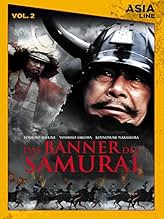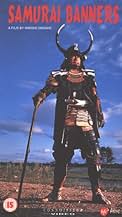Agrega una trama en tu idiomaA shrewd 16th Century samurai helps a daimyo expand his realm.A shrewd 16th Century samurai helps a daimyo expand his realm.A shrewd 16th Century samurai helps a daimyo expand his realm.
- Dirección
- Guionistas
- Elenco
Kanzaburô Nakamura
- Katsuyori Takeda
- (as Kankurô Nakamura)
Kôji Nanbara
- Ronin
- (sin créditos)
- Dirección
- Guionistas
- Todo el elenco y el equipo
- Producción, taquilla y más en IMDbPro
Opiniones destacadas
Lots of attention to historical detail, like the horned kabuto worn by Yamamoto Kansuke. Climactic battle (4th Kawanakajima)between the Takeda and Uesugi well worth seeing. Story told from the viewpoints of Kansuke and his overlord, Takeda Shingen. I liked this a lot more than the 1990 "Heaven and Hell," which retold the story of the rivalry between Takeda Shingen and Uesugi Kenshin, but from Kenshin's viewpoint. For example, the later movie seemed less accurate and more artsy (each side's soldiers all wore the same standard-color sashimono)in its depiction of the same battle.
For the whopping 2 hours and 45 minutes it lasts, Samurai Banners really has little to recommend it. Long movies are fine if that's how much it takes to communicate what you have to say, but there's a good 45 minutes here that could have been clipped and it would still be the same movie.
Furin Kazan (as is the original title) was the name of the war banners used by one of the greatest warlords of 16th century Japan, Takeda Shingen, lord of the Takeda clan. The name is derived from Sun Tzu's famous book "Art of War", meaning "Swift as the Wind, Silent as a Forest, Fierce as Fire and Immovable as a Mountain". The movie recalls the early years of Takeda leading up to the defining battle of Kawannakajima. If the name is familiar, that's because it's the same character depicted by Tatsuya Nakadai in Akira Kurosawa's Kagemusha (there in his later years). Indeed, coming near the end of a prolific career, in many ways this is Hiroshi Inagaki's Kagemusha.
Where SB falters is that it spends far too much time in namesdropping and planning battles than it does in actually showing them. Lots of build-up but little as far as spectacle goes. A mixture of politics, war strategy, romance and drama, this jidai-geki desperately calls for something to spice things up. The battle scenes are few and far between and really not very well choreographed. The final battle scene is particularly anti-climactic, more so after the massive built-up that leads to it. There's nice use of colours in banners and some beautiful exterior shots but much like Kagemusha, it feels like a dress rehearsal for a better movie. The extras seem to be going through the motions instead of giving it their all. Unlike Kagemusha though, this one doesn't have the deep character drama to go with it.
Fortunately for us and perhaps the only thing that holds things together, is the typically fantastic Toshiro Mifune giving another solid performance. Playing Takeda Shingen's right hand, an ambitious man with dreams of a big, unified Japan under Takeda's banner, he's consistently great. Of course he doesn't do anything he hasn't done better under Kurosawa's direction, but he's always a pleasure to watch.
Furin Kazan (as is the original title) was the name of the war banners used by one of the greatest warlords of 16th century Japan, Takeda Shingen, lord of the Takeda clan. The name is derived from Sun Tzu's famous book "Art of War", meaning "Swift as the Wind, Silent as a Forest, Fierce as Fire and Immovable as a Mountain". The movie recalls the early years of Takeda leading up to the defining battle of Kawannakajima. If the name is familiar, that's because it's the same character depicted by Tatsuya Nakadai in Akira Kurosawa's Kagemusha (there in his later years). Indeed, coming near the end of a prolific career, in many ways this is Hiroshi Inagaki's Kagemusha.
Where SB falters is that it spends far too much time in namesdropping and planning battles than it does in actually showing them. Lots of build-up but little as far as spectacle goes. A mixture of politics, war strategy, romance and drama, this jidai-geki desperately calls for something to spice things up. The battle scenes are few and far between and really not very well choreographed. The final battle scene is particularly anti-climactic, more so after the massive built-up that leads to it. There's nice use of colours in banners and some beautiful exterior shots but much like Kagemusha, it feels like a dress rehearsal for a better movie. The extras seem to be going through the motions instead of giving it their all. Unlike Kagemusha though, this one doesn't have the deep character drama to go with it.
Fortunately for us and perhaps the only thing that holds things together, is the typically fantastic Toshiro Mifune giving another solid performance. Playing Takeda Shingen's right hand, an ambitious man with dreams of a big, unified Japan under Takeda's banner, he's consistently great. Of course he doesn't do anything he hasn't done better under Kurosawa's direction, but he's always a pleasure to watch.
One of the best samurai epics. "Furinkazan" tells the story of the 16th century warlord Takeda Shingen and his loyal general Yamamoto Kansuke (Mifune Toshiro) embedded in the story of the Takeda clan's rise to power. Outstanding sets, costumes and Sato Masaru's rich soundtrack make the drama highly enjoyable.
I find myself a little surprised, and taken aback. There is an unsubtle directness in the writing that's actually kind of jarring and off-putting as bare-faced dialogue and scenes advance the plot in a blunt, stilted, and almost forceful manner. Despite the presumed complexity of characters who would scheme, stand opposed in various ways, and find themselves in complicated relationships, these figures feel flat and maybe even uninspired as they present, as if they weren't fleshed out any more than the dialogue and scenes seem to be. Just as the narrative at large is impacted, I believe these sensibilities also extend to the direction of Inagaki Hiroshi - confounding, coming from the man behind such stellar, refined classics as the "Samurai trilogy" of the mid-50s. In orchestrating scenes and guiding his cast Inagaki here lacks the patient polish and finesse he has demonstrated elsewhere, and 'Samurai banners' is prone to a brusqueness that's frankly unseemly when stood next to the many esteemed jidaigeki that came from the 50s, 60s, and 70s in particular. The thoughtful, deliberate craftsmanship and storytelling is diminished if not absent, further observed in instances of cinematography, editing, gawky on-screen text and graphics, and even the acting; icon that he remains, even Mifune Toshiro seems bound and restricted by such traits.
It's hardly that this picture is bad. Yet while it was surely fashioned with the same skill and intelligence as its kin, the same level of care was plainly not applied, and the relative weaknesses and shortcomings are plainly evident. The story has potential on paper but is shortchanged in realization, and is not as strong as it might have been; the writing is sometimes altogether troubled, and the direction and acting struggle to impress. Scattered moments that are unquestionably more sure-footed (e.g., in a short scene between Princess Yu and Yamamoto a bit after the one-hour mark) only get us so far, and likewise the contributions of those operating behind the scenes. The filming locations are lovely, and the sets as well; fine attention went into the costume design, hair, and makeup. Even if it sometimes feels out of place, I greatly appreciate Sato Masaru's score in and of itself. Where stunts, effects, fight choreography, and action sequences are employed they broadly look fantastic. Be that as it may, we can get these elements elsewhere, and respectfully, they are not necessarily the most important factors in determining the success of a feature. And as those most important factors are at best variable in their quality, the subsequent effect on the viewing experience is sadly one of partial enfeeblement.
My words have intoned criticism more than praise, and that's not quite right. More than not 'Samurai banners' is well made, and enjoyable. Nevertheless, the rough edges that define its construction quash much of what weight the saga should carry, not least as the writing also commonly fails to communicate the significance of the course of events, even including battles. Moreover, I wonder if that difficulty isn't worse in the second half. Where the movie adds dramatic flourish to accentuate a beat, it feels overdone and false. We all know what great capabilities were possessed by all who participated here, and still I don't think this is an especially worthy representation of them - more like a facsimile in which the fidelity of the ideal form has been lost. Though still suitably worthwhile on its own merits, even at its best this could only earn a soft recommendation when stood next to any kindred works, and maybe even that's a tad too kind. Watch if you have the opportunity, sure, but don't go out of your way for it, and be aware that even with Inagaki and Mifune on hand, among many celebrated others, this has faults which distinctly hold it back.
It's hardly that this picture is bad. Yet while it was surely fashioned with the same skill and intelligence as its kin, the same level of care was plainly not applied, and the relative weaknesses and shortcomings are plainly evident. The story has potential on paper but is shortchanged in realization, and is not as strong as it might have been; the writing is sometimes altogether troubled, and the direction and acting struggle to impress. Scattered moments that are unquestionably more sure-footed (e.g., in a short scene between Princess Yu and Yamamoto a bit after the one-hour mark) only get us so far, and likewise the contributions of those operating behind the scenes. The filming locations are lovely, and the sets as well; fine attention went into the costume design, hair, and makeup. Even if it sometimes feels out of place, I greatly appreciate Sato Masaru's score in and of itself. Where stunts, effects, fight choreography, and action sequences are employed they broadly look fantastic. Be that as it may, we can get these elements elsewhere, and respectfully, they are not necessarily the most important factors in determining the success of a feature. And as those most important factors are at best variable in their quality, the subsequent effect on the viewing experience is sadly one of partial enfeeblement.
My words have intoned criticism more than praise, and that's not quite right. More than not 'Samurai banners' is well made, and enjoyable. Nevertheless, the rough edges that define its construction quash much of what weight the saga should carry, not least as the writing also commonly fails to communicate the significance of the course of events, even including battles. Moreover, I wonder if that difficulty isn't worse in the second half. Where the movie adds dramatic flourish to accentuate a beat, it feels overdone and false. We all know what great capabilities were possessed by all who participated here, and still I don't think this is an especially worthy representation of them - more like a facsimile in which the fidelity of the ideal form has been lost. Though still suitably worthwhile on its own merits, even at its best this could only earn a soft recommendation when stood next to any kindred works, and maybe even that's a tad too kind. Watch if you have the opportunity, sure, but don't go out of your way for it, and be aware that even with Inagaki and Mifune on hand, among many celebrated others, this has faults which distinctly hold it back.
It should be noted that this DVD was about 20 minutes shorter than the time listed on IMDb. I assume that a bit of it was trimmed for the American and Canadian DVD release. While this is regrettable, the DVD producers fortunately decided not to dub the film but presented it with subtitles--something far preferable to most cinemaniacs.
As for the film, it's a historical drama about Shingen Takeda's attempt to conquer medieval Japan. In particular, it focuses on his right hand man, Kansuke Yamamoto (Toshirô Mifune), who doggedly pushed his master (Takeda) to be very cunning and amoral in his pursuit of power. Yamamoto was a great strategist and he and Takeda were of one mind during most of the film. Only later in the film does Takeda try his own plan.
Along the way, a headstrong princess is captured. While Yamamoto was always loyal, it seemed as if unresolved sexual tension existed between him and the princess. Yamamoto's fanatical loyalty to her and her son were evidence of his attraction to her--particularly when he could have sided with Takeda's wife.
While there is some of the film concerns life behind the scenes, much of it had to do with one battle after another as well as showing details of the battle plans in the later battles. All this makes the film great for military strategists and people who love war films, but it also makes the film a bit stale--taking away some of the heart of the film. Frankly, after a while I found myself really respecting the film for its attention to detail but also feeling disconnected as a result of all the battles. I also think that if you are very, very well-versed with medieval Japanese history this all might be a bit more interesting. I have more knowledge than 99% of the Americans that might watch this film since I have been a history teacher, but some of the subtleties of the film still eluded me. Because of this, it's important to watch the included "program notes" BEFORE you see the film. I did, however, like the arrow in the eye near the end.
Overall, a very well made but standard war picture. If you love war films (and I don't), you'll enjoy this one. If not, then it might be a bit of a chore to watch--especially since it's about three hours long.
As for the film, it's a historical drama about Shingen Takeda's attempt to conquer medieval Japan. In particular, it focuses on his right hand man, Kansuke Yamamoto (Toshirô Mifune), who doggedly pushed his master (Takeda) to be very cunning and amoral in his pursuit of power. Yamamoto was a great strategist and he and Takeda were of one mind during most of the film. Only later in the film does Takeda try his own plan.
Along the way, a headstrong princess is captured. While Yamamoto was always loyal, it seemed as if unresolved sexual tension existed between him and the princess. Yamamoto's fanatical loyalty to her and her son were evidence of his attraction to her--particularly when he could have sided with Takeda's wife.
While there is some of the film concerns life behind the scenes, much of it had to do with one battle after another as well as showing details of the battle plans in the later battles. All this makes the film great for military strategists and people who love war films, but it also makes the film a bit stale--taking away some of the heart of the film. Frankly, after a while I found myself really respecting the film for its attention to detail but also feeling disconnected as a result of all the battles. I also think that if you are very, very well-versed with medieval Japanese history this all might be a bit more interesting. I have more knowledge than 99% of the Americans that might watch this film since I have been a history teacher, but some of the subtleties of the film still eluded me. Because of this, it's important to watch the included "program notes" BEFORE you see the film. I did, however, like the arrow in the eye near the end.
Overall, a very well made but standard war picture. If you love war films (and I don't), you'll enjoy this one. If not, then it might be a bit of a chore to watch--especially since it's about three hours long.
Selecciones populares
Inicia sesión para calificar y agrega a la lista de videos para obtener recomendaciones personalizadas
Detalles
- Tiempo de ejecución2 horas 45 minutos
- Mezcla de sonido
- Relación de aspecto
- 2.35 : 1
Contribuir a esta página
Sugiere una edición o agrega el contenido que falta


























